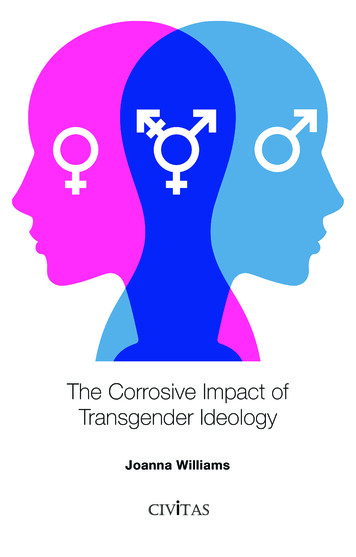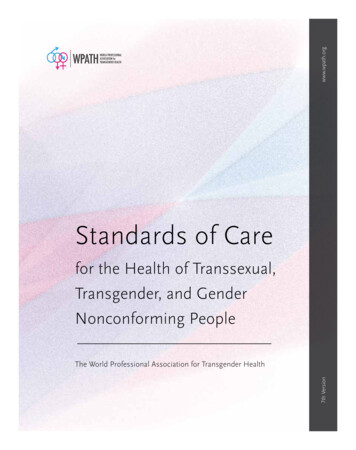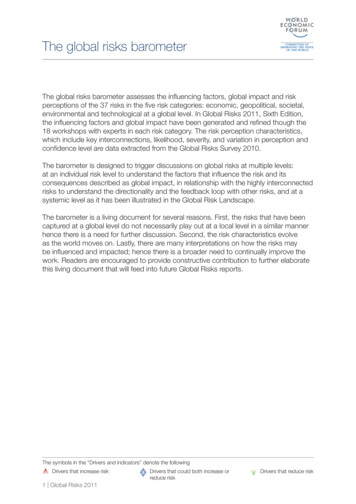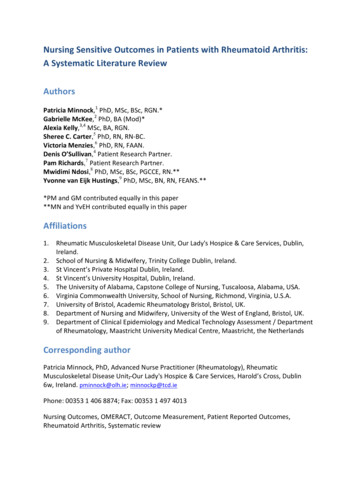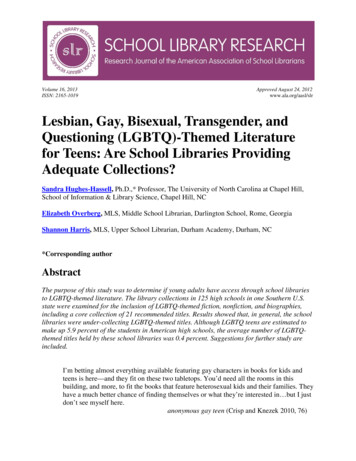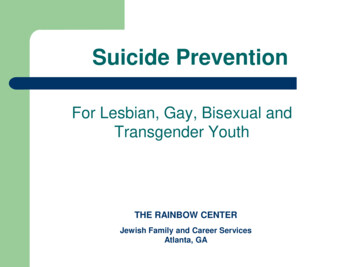
Transcription
5/27/2014Transgender Youth: Needs, Risks, Outcomes andthe Role of the SystemJohanna Olson, MDMedical Director – TheCenter for TransyouthHealth and DevelopmentChildren’s Hospital LosAngelesAydin Kennedy, MSW,ACSWTransgender HealthProgram CoordinatorSt. John’s Well Child andFamily CenterLos Angeles, CAPrepared for: Improving Permanency & Inclusion For Our YouthSan Diego, CAMay 14, 2014Objectives Understand the developmental process of gender non- conformingand transgender youth. Understand how privilege, and the dominant cultures expectations ofgender and sexuality impact gender non-conforming and transgenderyouth. Understand the basic needs of gender non-conforming andtransgender youth. Recognize that gender non-conforming and transgender youth who donot get timely and appropriate treatment are at risk for multiplenegative mental health and behavioral outcomes. Improve skills required for advocating on behalf of gender nonconforming and transgender youth.1
5/27/2014Gender is PERVASIVE Most people don’t have to think aboutgender2
5/27/20143
5/27/2014When do we begin to gender? It’s a Genital Anatomy4
5/27/20145
5/27/2014Gender IdentityA person’s basic sense of being male orfemale, especially as it is experienced in selfawareness and behaviorMilDred –The Nursha Project6
5/27/2014L G B T Q I Pick one? Choose all that apply?What happens when a child does not fit intotheir assigned categories?Sex: FM7
5/27/2014Gender Identity Do you know what sex you are?How do you know?When did you come to know this? What were you allowed to do or not do because of the genderyou were assigned by others? Was there ever a time when your sense of your gender and thesocial rules around you didn’t match?How did this feel?How did it impact you? Who and/or what policed you around the performance of yourgender?What has the impact been on you?8
5/27/2014How have your experiences around gendershaped your beliefs regarding genderidentity, expression and roles?Gender Identity The internal sense of being male, female, neither or both. Can shift over time, is not static. Everyone has a gender identity. Is solely about ones sense of self, is not related to attraction toothers. Is an innate experience, i.e., not a choice.9
5/27/2014Gender ExpressionThe way in which a person acts tocommunicate gender within a given cultureDysphoriaGender dysphoria is widelydescribed and experienced aspersistentphysical/emotional/and/orpsychological distress due todiscomfort with one’sassigned sexGender dysphoria isn’t alwaysexperienced or expressed asbeing related to one’s genderor secondary sexcharacteristics10
5/27/2014Gender performance is expected to fit into a very narrow box andthese expectations are institutionalized rmativityA set of social/political/ideologicalnorms that holds that people fallinto distinct and complementarygenders (man and woman) withnatural roles in life.It asserts that heterosexuality is theonly sexual orientation or only norm,and states that sexual and maritalrelations are most (or only) fittingbetween people of opposite sexes.Consequently, a "heteronormative"view is one that involves alignmentof biological sex, sexuality, genderidentity and gender roles.11
5/27/2014Heterosexism is a system of attitudes, bias, and discrimination in favor ofopposite-sex sexuality and relationships it is based on the presumption thatpeople are heterosexual or that opposite-sex attractions and relationshipsare the only normCissexism is sometimesused as a synonym oftransphobia.Refers to the assumptionsthat due to human sexualdifferentiation one'sgender as either a man ora woman is determinedsolely by a "biological" sexof male or female.And that trans people areinferior to cisgenderpeople.12
5/27/2014Privilege The paradigm that makes the world easier for cisgender individuals tonavigate their world. There may be some blind spots with regards to understanding wheretrans* folks are coming from. People may have multiple levels of privilege, to say that we all areoppressed or unprivileged in someway is true but it also downplays theexperiences of trans* people who have additional barriers/multipledisparities to overcome. The more layers you have as a minority the more potential barriers therewill be in way for you. You can use public restrooms, locker rooms or dressing roomswithout fear of verbal abuse, physical intimidation, or arrestAndraya Williams, a 22 year-old student at Central PiedmontCommunity College in Charlotte, was escorted off campus,suspended and would only be allowed back if she used the genderneutral bathroom .the dean requested proof that she was afemale. “He told her she had to bring in medical proof of being afemale if she wanted to use the female restroom.”13
5/27/2014 Strangers don’t assume they can ask you what your genitalslook like or if you are “post op” You are never told that you are a boy/man with a girls/woman’sbody or a girl/woman with a boys/man’s body.I am not trapped in the wrong body – my selfhood is not something divided againstitself, swallowed up by and choking on itself – but it is something suffocated by theweight of the body and expectations imposed upon it by society. Your validity as a man/woman/human is not based on how muchsurgery you’ve had or how well you “pass” as non-transgender. You have the ability to walk through the world and generally blendin, not being constantly stared or gawked at, whispered about,pointed at, or laughed at because of your gender expression.14
5/27/2014 If you end up in the emergency room, you do not have to worrythat your gender will keep you from receiving appropriatetreatment, or that all of your medical issues will be seen as aresult of your gender. Your identity is not considered a mental pathology (“genderidentity disorder” in the DSM IV) by the psychological and medicalestablishments. You are not required to undergo an extensive psychologicalevaluation in order to receive basic medical care. You are never asked when you began living “full time”. You can easily find role models and mentors to emulate who shareyour identity.15
5/27/2014 No stranger checking your identification or drivers license willever insult or glare at you because your name or sex does notmatch the sex they believed you to be based on your genderexpression. You can reasonably assume that you will not be denied servicesat a hospital, bank, or other institution because the staff doesnot believe the gender marker on your ID card to match yourgender identity. Strangers call you by the name you provide, and don’t ask whatyour “real name” [birth name] is and then assume that theyhave a right to call you by that name because it is “easier” forthem You don’t have to think about how you are going toanswer “what is your sex and/or gender” when you arefilling out forms.16
5/27/2014 You do not have to choose between either invisibility ("passing")or being consistently "othered" You don’t have to convince your parents of your true genderand/or have to earn your parents’ and siblings’ love and respectall over again Lifesaving, medically necessary medications are not used as acarrot or something you have to earn after you . You are not told that your sexual orientation and gender identityare mutually exclusive17
5/27/2014 Privilege is defined as a special right,advantage, or immunity granted or availableonly to a particular person or group of people. Privilege exists within the trans communityAbility to transitionEducationRace/ethnicityGeographic locationSupportEmploymentSocioeconomic backgroundTrans male/Trans female Having the choice to disclose or not discloseLilly and her high heels18
5/27/2014What does it mean in our societyto act like a man ?What are the characteristics ofmasculinity?What do we say when men are notperforming their “maleness” correctly?What physically happens when a manisn’t acting “male enough”What does it mean to act like awoman?What are the characteristics offemininity?What do we say when women are notperforming their “femaleness” correctly?What physically happens when a womanisn’t acting “female correctly?”19
5/27/2014Privilege and Exchange of Status Trans MenAcquire authorityFree expression of femininityIncreased social capitalNavigating rape culture/patriarchal society Trans WomenFear of safetyMore rigid rules of expressionNegotiation of patriarchy, misogyny, sexism, etc.Decreased social capitalSome signs of indirect genderdysphoria Continual difficulty with simply getting through the day A sense of misalignment, disconnect, or estrangement fromyour own emotions A feeling of just going through the motions in everyday life, asif you’re always reading from a scriptEverything always seemed like it was somehow less real than it ought to be.I didn’t feel like I was my own person – I had no sense of myself assomeone who could make my own choices and decisions as I wished. Ioften lacked that internal initiative that wants things and seeks things forno reason other than the fact that you simply want them and that’s that.20
5/27/2014 A seeming pointlessness to your life, and no sense of any realmeaning or ultimate purpose Knowing you’re somehow different from everyone else, andwishing you could be normal like them.“I often wondered how other kids could just go about their lives, talkingand laughing and being so calm and happy, like nothing was wrong.” Attempting to fix this on your own through various copingmechanisms. Substantial resolution of these symptoms in a very obviousway upon transitioning, particularly upon initiating HRT. The many intersecting identities of individuals are oftenviewed through the lens of the dominant cultureSexuality we think about non heterosexual/queer identitiesClass we most often think of those who are poor or living in povertyRace/ethnicity we most often think of people of color The consequence of this paradigm is a White, middle class,heteronormative, cisgender story that trans people are unableto fit into Therefore, a non-celebrated identity is formed within anoppressed, paradigm and community and my be difficult tointegrate21
5/27/2014Gender Development By the age of 3 years, most children expressan interest in or preference toward activitiesand behaviors typically associated with theirspecific genderFIRST MAJOR CONFLICT!22
5/27/2014Approaches to Gender Non-Conforming Children Reparative therapy “Wait and see” approach Affirmative Model/Social transitionReparative/Corrective Therapy Doesn’t work Is likely harmful Senate Bill No. 117223
5/27/2014Can Gender Identity be Changed? What drives gender-typical or gender-nonconforming traits cannot be changed throughthe influence of parents, teachers, coaches ortherapists Behavior can be changed, but internal sense ofgender will not be changedWhat is Social/Non-MedicalTransition? Outward expression of internal genderLiving in asserted genderClothes, hairstyle, names, pronounsREVERSIBLEControversial for children24
5/27/2014Typical presentations of TransgenderYouth and Young Adults Consistent, persistent, insistent gender nonconformity childhood history No prior non-conformingbehaviors/indicators in childhood butgender dysphoria is unveiled at thebeginning of puberty Late presentersPhases of Transitioning Reversible (social/non-medical) - clothes, hair,shoes, toys, name, pronouns Reversible (medical) - puberty blockers Partially reversible - cross sex hormonereplacement therapy Irreversible - sexual reassignment surgery(SRS)25
5/27/2014History of Early TreatmentAnnelou L. C. de Vries MD, PhD & Peggy T. Cohen-Kettenis PhD (2012): ClinicalManagement of Gender Dysphoria in Children and Adolescents: The Dutch Approach,Journal of Homosexuality, 59:3, 301-32026
5/27/2014Annelou L. C. de Vries MD, PhD & Peggy T. Cohen-Kettenis PhD (2012): ClinicalManagement of Gender Dysphoria in Children and Adolescents: The Dutch Approach,Journal of Homosexuality, 59:3, 301-320Annelou L. C. de Vries MD, PhD & Peggy T. Cohen-Kettenis PhD (2012): ClinicalManagement of Gender Dysphoria in Children and Adolescents: The Dutch Approach,Journal of Homosexuality, 59:3, 301-32027
5/27/2014Transgender vs. Gender Dysphoric Gender dysphoria is the persistent distress anindividual experiences related to theincongruence between assigned gender atbirth and gender identity A disorder is a description of something withwhich a person might struggle, not adescription of the person or the person’sidentity. – WPATH SOC 7Endocrine Treatment of Transsexual Persons -200928
5/27/2014When to start GnRH analogues?Individual approach – no cookie cutter protocol Persistent and prolonged asserted gender identity thatis not aligned with physical body Dysphoria at initiation of mismatched puberty Social support system in place to facilitate appropriatefollow up care Absence of psychiatric disorder that would potentiallyconfound the diagnosis of gender dysphoriaGnRH analogue treatment GnRHa effects are fully reversible “Buy time” and avoid reactivedepression at the same time Prevention of unwanted secondary sexcharacteristics Psychotherapy is facilitated when distressis eased29
5/27/2014Types of GnRH analogues-US Histrelin (SupprelinLA) is an implant, a smallrod, placed in the underside of the arm that iseffective for one year Leuprolide acetate is an injection that iseffective for either one or three months Neither of these medications are FDAapproved for this purposeBarriers to careOR 30
5/27/2014Adolescent Presentation Onset of puberty may cause severe distress Behavior problems, depression, suicidal ideationcan be initial presentation of genderincongruence Previously suppressed cross-sex behaviors maystart emerging which may lead to victimization Many youth come out as gay Many have negative experiences with authorityfigures (including physicians and therapists)Onset of Puberty DepressionAnxietySuicidalitySocial isolationSelf-harmHigh-risk sexualbehavior Maladaptive coping31
5/27/2014Moving Forward – Cross sex hormones Goals– Masculinize or feminize the body– Improve quality of life– Improve body esteem– Decrease gender dysphoria– Diminish anxiety, depression– Decrease high risk behaviorsBenefits of early treatment Improve family functioning, schoolperformance Prevent suffering and risk taking Leads to social change and improves quality oflife Spares surgical interventions Affords a gender concordant puberty32
5/27/2014Early TreatmentUn-monitored hormone use “Black market” - street hormonesFriendsMexicoInternetLocal pharmacy33
5/27/2014Hormonal Intervention - TranswomenLydia KullickEffects of Feminizing Hormones Development of breast tissueDecreased body hairSofter skinFat redistributionDecreased muscle massGenital changesInfertility34
5/27/2014Feminizing Hormones DO NOT Cause the voice to increase in pitchDramatically reduce facial hair growth Change the shape or size of bonestructureRisks Related to Estrogen Thrombosis Hypertension Increasedprolactin/prolactinoma Gallstones Breast cancer – very fewcase reports Fluid retention Liver disease Weight gain Mood swings35
5/27/2014Risks of Feminizing Hormones Complete risks in transwomen are unknown– Most studies are performed in biological women– Limited research– All administration is thus “off-label”– Mortality not necessarily increasedEffects of Anti-Androgens Reduces testosterone effects Reduces male pattern hair GROWTH Reduces erections36
5/27/2014Risks of SpironolactoneHyperkalemia (high potassium levels)HypotensionFeminizing Hormones Effects vary from patient to patient—familial, genetictendencies Younger patients generally obtain better and morerapid results Noticeable changes within 2-3 months Irreversible effects within 6 months Feminization continues at a decreasing rate for twoyears or more37
5/27/2014Reversible changes of testosterone Increased libido Redistribution ofbody fat Cessation ofovulation andmenstruation Further muscledevelopment Increased sweat andchanges in bodyodor Prominence of veinsand coarser skin Acne Alterations in bloodlipids Increased red bloodcell countIrreversible changes of testosterone Deepening of the voiceGrowth of facial and body hairMale pattern baldnessClitoral enlargementPossible shrinking/softening of breast tissue38
5/27/2014Risks of Testosterone Weight Aggressive/mood changes Liver dysfunction TG HDL LDL Insulin resistance Polycythemia Male pattern baldness Pelvic pain ?39
5/27/2014The Role of the Mental HealthProfessionalNot a gatekeeperResiliency toolbox builderAddressing the inevitableRole playingDiminishing fear of the unexpected withpreparation The medical establishment does not serve as a "gatekeeper"which disallows self-determination of what happens to my body.40
5/27/2014Therapy for trans people is a process of preparingfor a world that is not prepared for them.The gatekeeper model can be counterintuitive tothis therapeutic goal.We ask youth who have least to do most.The most obvious and and important realities areoften the ones that are hardest to see and talkabout.Potential Consequences toGatekeepingThree things that are often under talked about intherapy1. Extent of past trauma/abuseFear of trauma being used to invalidate gender identity2. Extent of ambivalence of transitionFear of needles, surgery, transition outcomes. Etc.41
5/27/2014Fixed, stereotypical ideas about how a transgenderperson should present for assistance and as a result,clients may alter their gender narratives to fit themedical modelPuts the mental health provider in a conflicting roleof both healer and evaluator, which can negativelyimpact rapport.Barriers to serviceLack of understanding Cisgender, heteronormative privilege/paradigmUntrained/undertrained mental health providersPoor or no access to comprehensive medical/mental healthcareAge of consent barriers Unsupportive parents/caretakers/Social WorkersFinancial barriers Under/uninsured Un/under-employeedPre-existing mental illness42
5/27/2014 Disclosed or undisclosed– Community/Identity– Pictures– Name– Relationships Having a “secret” can be a burden and may beexperienced as a new form of an old secret– Trans youth may be additionally burdened withpast trauma secrets When an individuals’ identity is continuallyquestioned or not witnessed, emotional, spiritual,psychological development of self may be moredifficult If this occurs on a regular basis, there may be anarrested development of ones emotional self43
5/27/2014 Therapy needs to include conversations aboutbodies, sex and sexuality.––––Including fertilitySafe sexDatingRelationships/disclosure Dysphoria– Explore what the client does with their body thatfeels good Dancing Exercise Encourage exploration of how to awaken vitality Front loading mental health care– Lends itself to the gatekeeper model– Carrot model of care “When you start doing better in school then you cantransition”– May miss the real need of post transition mental healthcare44
5/27/2014Self-esteem/Adaptation/IntegrationTG-AIM (transgender adaptation and integration model)Gender-Related Fears - concerns related to discriminationPsychosocial Impact of Gender Status - focuses on the effectof gender incongruence on mental health, quality of life andinterpersonal relationshipsCoping and Gender Reorientation Efforts - focus on effortstoward the integration of internal gender identity andassigned sex and anatomyRosenberg self-esteem scaleThose scoring between 15-25 are considered to be within the normalrange for self-esteem. Scores below 15 indicate poor self-esteem.Self-esteem/Adaptation/IntegrationN 23967% were assigned female, and 31% were assigned maleMean age 3480% White/Caucasian85% of respondents lived in the United StatesMinimum age of identifying was 3, max 65, mean age 13Minimum age of disclosure was 3, max 66, mean age 2745
5/27/2014Those who were three years or more post medicaltransition reported having decreased Gender-RelatedFears, Psychosocial Impact on Gender Status and higherCoping and Gender Reorientation skills than those whomore recently transitioned.The total TG-AIM score was also significantly higher forthis group. Their mean total score was 27.8 as comparedwith 19.5 for those who more recently transitioned.Overall self-esteem scores were also found to be higherfor those who were more than three years post medicaltransition with a mean score of 20.5, as comparedwith17.5 for those who had transitioned within the lastthree years.It is important to note that youth who transition at ayounger age arrived at the three-year post transitionmark at an earlier age than older individuals.As a result they may have experienced better self-esteemand adjustment over the life span.Those who were within the first two years of medicaltransition reported lower levels of self-esteem and thisindicated a greater struggle with adjustment.This information can be used to better understand theimportance of medical, mental health, family and peersupport during this fragile time of identity development.46
5/27/2014ReferencesAchenbach, T. M., & Edelbrock, C. (1981). Behavioural problems and competences reported by parents ofnormal and disturbed children aged 4 to 16. Monographs Of the Society for Research in ChildDevelopment, 46, 1-82.Alizadeh,H. (2010). Iran: transgender people no longer classified as “mentally sick”. (translation of Fars newsagency report). Available on the website of the global forum on MSM and HIV (accessed 8 th June 2011 nis, P., & Pfafflin, F. (2003). Transgenderism and Intersexuality in Childhood andAdolescence:Making Choices. Thousand Oaks: Sage.De Cuypere, G., Van Hemelrijck, M., Michel, A., Carael, B., Heylens, G., Rubens, R., et al. (2007). Prevalence anddemography of transsexualism in Belgium. European Psychiatry, 22(3), 137-141.Gates, G. (2011). How many people are LGBT? Los Angeles: UCLA School of Law, Williams Institute. Retrieved 8June 2011, from -many-people-are-LGBT-Final.pdfRametti et al, White matter microstructure in female to male transsexuals before cross-sex hormonaltreatment. A diffusion tensor imaging study, Journal of Psychiatric Research, Volume 45, Issue 2, Pages199-204Reed, B., Rhodes, S., Schofield, P., & Wylie, K. (2009). Gender variance in the UK: prevalence, incidence, growthand geographic distribution. Accessed 8th June 2011 at eUK-report.pdfTsoi, W. F. (1988). The prevalence of transsexualism in Singapore. Acta Psychiatrica Scandinavica, 78(4), 501504.Veale, J. (2008). Prevalence of transsexualism among New Zealand passport holders. Australian & New ZealandJournal of Psychiatry, 42(10), 887-889Verhulst, F. C., Van der Ende, J., & Koot, H. M. (1996). Handleiding voor de CBCL/4-18. Rotterdam: AfdelingKinder- en Jeugdpsychiatrie, AZ/Erasmus Universiteit.Winter and Conway, How many trans* people are there? A 2011 update incorporating new data;http://web.hku.hk/ le-are-there.htmZucker, K., Bradley, S., Owen-Anderson, A., Kibblewhite, S., & Cantor, J. (2008). Is gender identity disorder inadolescents coming out of the closet? Journal of Sex and Marital Therapy(34), 287-290.47
look like or if you are “post op” You are never told that you are a boy/man with a girls/woman’s body or a girl/woman with a boys/man’s body. I am Your validity as a man/woman/human is not based on how much surg
